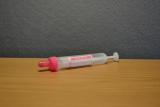Test Directory
MRD Monitoring NPM1
Containers - Adult

Red Cap Tube EDTA KE 9ml
|
|
Laboratory Site
Edinburgh
EH4 2XU
Transport arrangements
Blood and bone marrow specimens should ideally arrive within 24 hours of collection (maximum of 48 hours). Specimens should arrive no later than 3.30pm on Friday. Samples should be sent to the following address:
Western General Hospital.
Haematology/Biochemistry Combined Reception
Immunophenotyping Laboratory
Crewe Road
Edinburgh
EH4 2XU
Sample storage arrangements
Room Temperature
How to request
HMDS Request form
Availability
Monday - Friday. 09:00 – 17:00
Anticipated turnaround
5 working days
(3 working days after treatment cycle 2)
Static information/disclaimer
This test is accredited to ISO 15189.
General additional information
NPM1 Methodology:
RNA is extracted using the Maxwell SimplyRNA blood kit (Promega). cDNA is synthesised by reverse transcription using the SuperScript IV VILO cDNA synthesis kit (ThermoFisher). Real-time PCR is performed to quantify mutant NPM1 transcripts according to Gorello et al [Leukemia 2006 20: 1103] and Ivey et al [N Engl J Med 2016 374: 422] and ABL1 transcripts according to Gabert et al [Leukemia 2003 17: 2318]. This assay carries a limit of detection 10 copies mutant NPM1 per 100 000 copies ABL1 (0.01%) when 2 microgram of RNA is utilised.
MRD high is defined as greater than 1000 copies mutant NPM1 transcripts per 100 000 copies ABL1 (bone marrow) or greater than 200 copies mutant NPM1 transcripts per 100 000 copies ABL1 (peripheral blood). MRD low is defined as the presence of mutant NPM1 transcripts at less than 1000 copies per 100 000 copies ABL1 (bone marrow) or less than 200 copies per 100 000 copies ABL1 (peripheral blood). MRD negative is defined as the absence of detectable mutant NPM1 transcripts (Dillon et.al [Blood 2020 135: 680]). Assay sensitivity is calculated according to Schuurhuis et al [Blood 2018 131:1275].